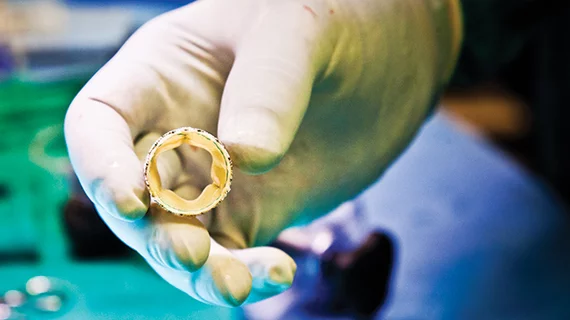Researchers: More evidence needed for TAVR in young patients
Researchers from Weill Cornell Medicine in New York are worried the extension of transcatheter aortic valve replacement (TAVR) to younger, intermediate-risk patients is outpacing clinical evidence.
Bioprosthetic valves may not hold up for the duration of younger patients’ lifetimes, they said, potentially leading to risky reoperations. TAVR was initially reserved for patients deemed inoperable for surgery, then moved to high-risk patients and is increasingly being seen as a viable treatment for people at intermediate surgical risk.
Art Sedrakyan, MD, PhD, and colleagues studied the National Inpatient Sample from 2012 through 2015 and found that 66 percent of TAVRs used bioprosthetic valves while the rest used mechanical valves. The proportion of TAVRs compared to surgical aortic valve replacements (SAVRs) increased across all age groups over the study period, according to the authors’ research letter published in the Journal of the American Medical Association.
“There is a high chance of reoperation in 10 to 15 years, which not only increases the cost substantially, but also leads to a higher-risk second procedure or surgery, as the patient will have aged and become more vulnerable to complications,” Sedrakyan said in a press release.
“The use of TAVR has expanded very fast. Now intermediate risk groups, often comprised of people younger than 65, are becoming eligible for the procedure. This is concerning because there is limited knowledge on the longevity of the bioprosthetic valves.”
The National Inpatient Sample represents 20 percent of all discharges from U.S. community hospitals. Extrapolating their data to the entire American population, the researchers estimated the number of patients younger than 65 who received TAVR increased from about 500 in 2012 to approximately 1,700 in 2015. They expect that 2015 figure to at least double by the end of this year, based on current trends.
“The lack of evidence and the limits of this technology that we know about raise the risk of harm for younger patients,” Sedrakyan said. “TAVR is an important technology that has changed many peoples’ lives, but even with the best innovations it is important for us to understand their limitations in order to avoid potential for harm.”
The authors called for additional clinical trials in younger patients comparing long-term outcomes for mechanical valves versus bioprosthetic valves. They also said registries and future studies should extend their follow-up durations to better inform younger patients about the downstream risks associated with the procedure.

